TOYOTA COROLLA 2020 Owners Manual (in English)
Manufacturer: TOYOTA, Model Year: 2020, Model line: COROLLA, Model: TOYOTA COROLLA 2020Pages: 588, PDF Size: 13.49 MB
Page 161 of 588
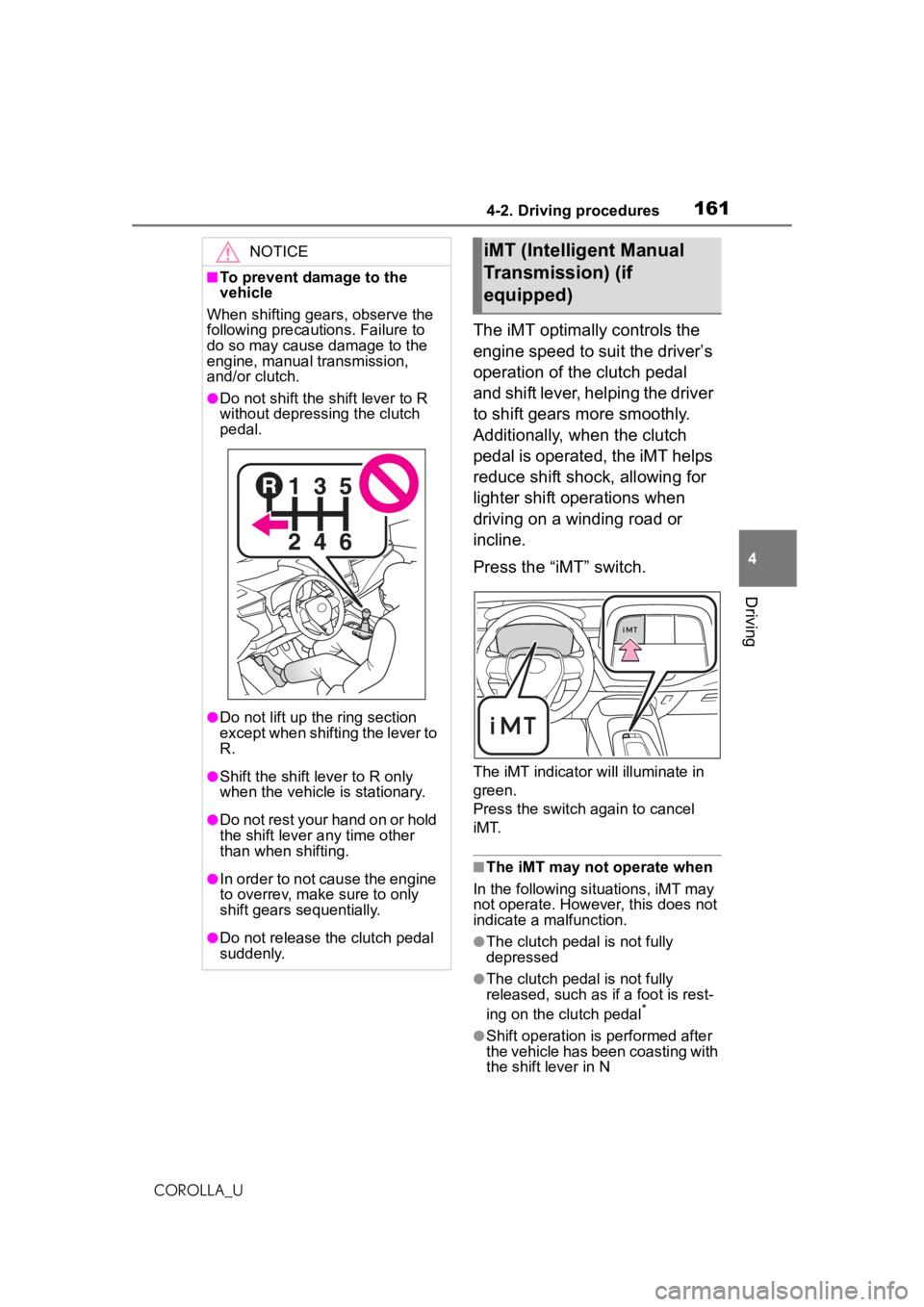
1614-2. Driving procedures
COROLLA_U
4
Driving
The iMT optimally controls the
engine speed to suit the driver’s
operation of the clutch pedal
and shift lever, helping the driver
to shift gears more smoothly.
Additionally, when the clutch
pedal is operated, the iMT helps
reduce shift shock, allowing for
lighter shift operations when
driving on a winding road or
incline.
Press the “iMT” switch.
The iMT indicator will illuminate in
green.
Press the switch again to cancel
i M T.
■The iMT may not operate when
In the following si tuations, iMT may
not operate. However, this does not
indicate a malfunction.
●The clutch pedal is not fully
depressed
●The clutch pedal is not fully
released, such as if a foot is rest-
ing on the clutch pedal
*
●Shift operation is performed after
the vehicle has been coasting with
the shift lever in N
NOTICE
■To prevent damage to the
vehicle
When shifting gears, observe the
following precautions. Failure to
do so may cause damage to the
engine, manual transmission,
and/or clutch.
●Do not shift the shift lever to R
without depressing the clutch
pedal.
●Do not lift up the ring section
except when shifting the lever to
R.
●Shift the shift lever to R only
when the vehicle is stationary.
●Do not rest your hand on or hold
the shift lever any time other
than when shifting.
●In order to not cause the engine
to overrev, make sure to only
shift gears sequentially.
●Do not release the clutch pedal
suddenly.
iMT (Intelligent Manual
Transmission) (if
equipped)
Page 162 of 588
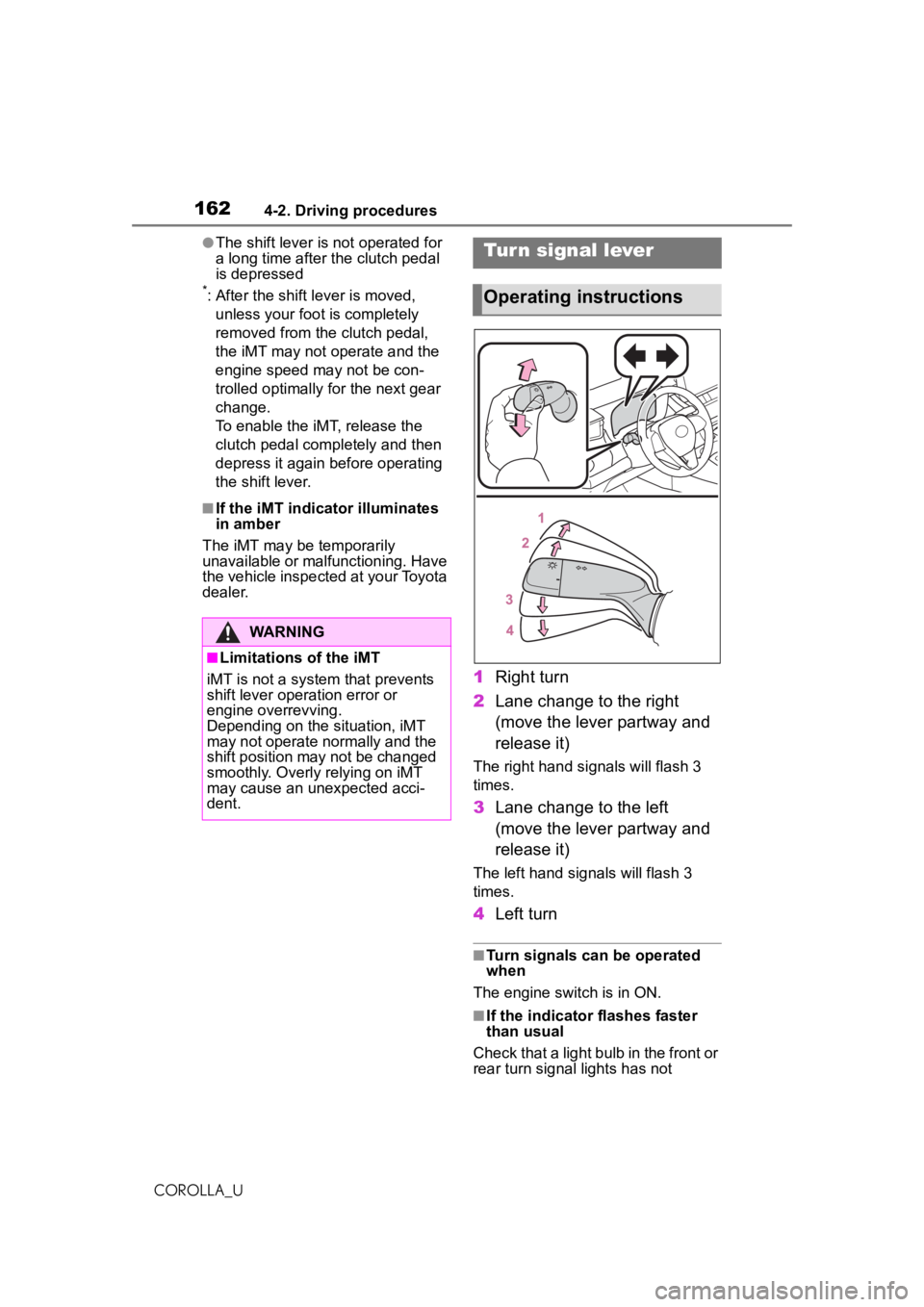
1624-2. Driving procedures
COROLLA_U
●The shift lever is not operated for
a long time after the clutch pedal
is depressed
*: After the shift lever is moved, unless your foot is completely
removed from the clutch pedal,
the iMT may not operate and the
engine speed may not be con-
trolled optimally for the next gear
change.
To enable the iMT, release the
clutch pedal completely and then
depress it again before operating
the shift lever.
■If the iMT indicator illuminates
in amber
The iMT may be temporarily
unavailable or malfunctioning. Have
the vehicle inspected at your Toyota
dealer.
1 Right turn
2 Lane change to the right
(move the lever partway and
release it)
The right hand signals will flash 3
times.
3Lane change to the left
(move the lever partway and
release it)
The left hand signals will flash 3
times.
4Left turn
■Turn signals can be operated
when
The engine switch is in ON.
■If the indicator flashes faster
than usual
Check that a light bulb in the front or
rear turn signal lights has not
WARNING
■Limitations of the iMT
iMT is not a system that prevents
shift lever operation error or
engine overrevving.
Depending on the situation, iMT
may not operate normally and the
shift position may not be changed
smoothly. Overly relying on iMT
may cause an unexpected acci-
dent.
Tur n signal lever
Operating instructions
Page 163 of 588
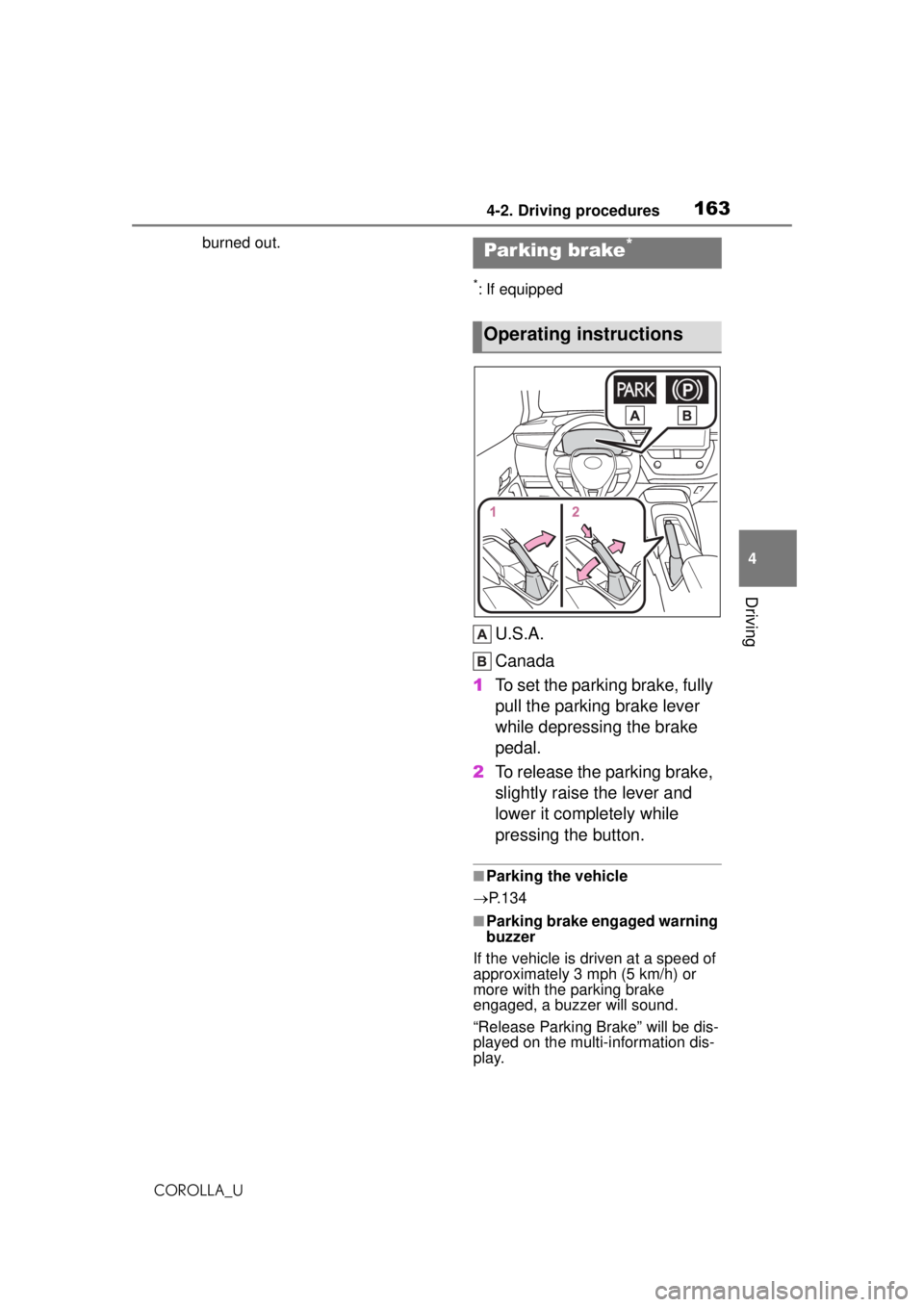
1634-2. Driving procedures
COROLLA_U
4
Driving
burned out.
*: If equipped
U.S.A.
Canada
1 To set the parking brake, fully
pull the parking brake lever
while depressing the brake
pedal.
2 To release the parking brake,
slightly raise the lever and
lower it completely while
pressing the button.
■Parking the vehicle
P.134
■Parking brake engaged warning
buzzer
If the vehicle is driven at a speed of
approximately 3 mph (5 km/h) or
more with the parking brake
engaged, a buzzer will sound.
“Release Parking Brake” will be dis-
played on the multi-information dis-
play.
Parking brake*
Operating instructions
Page 164 of 588
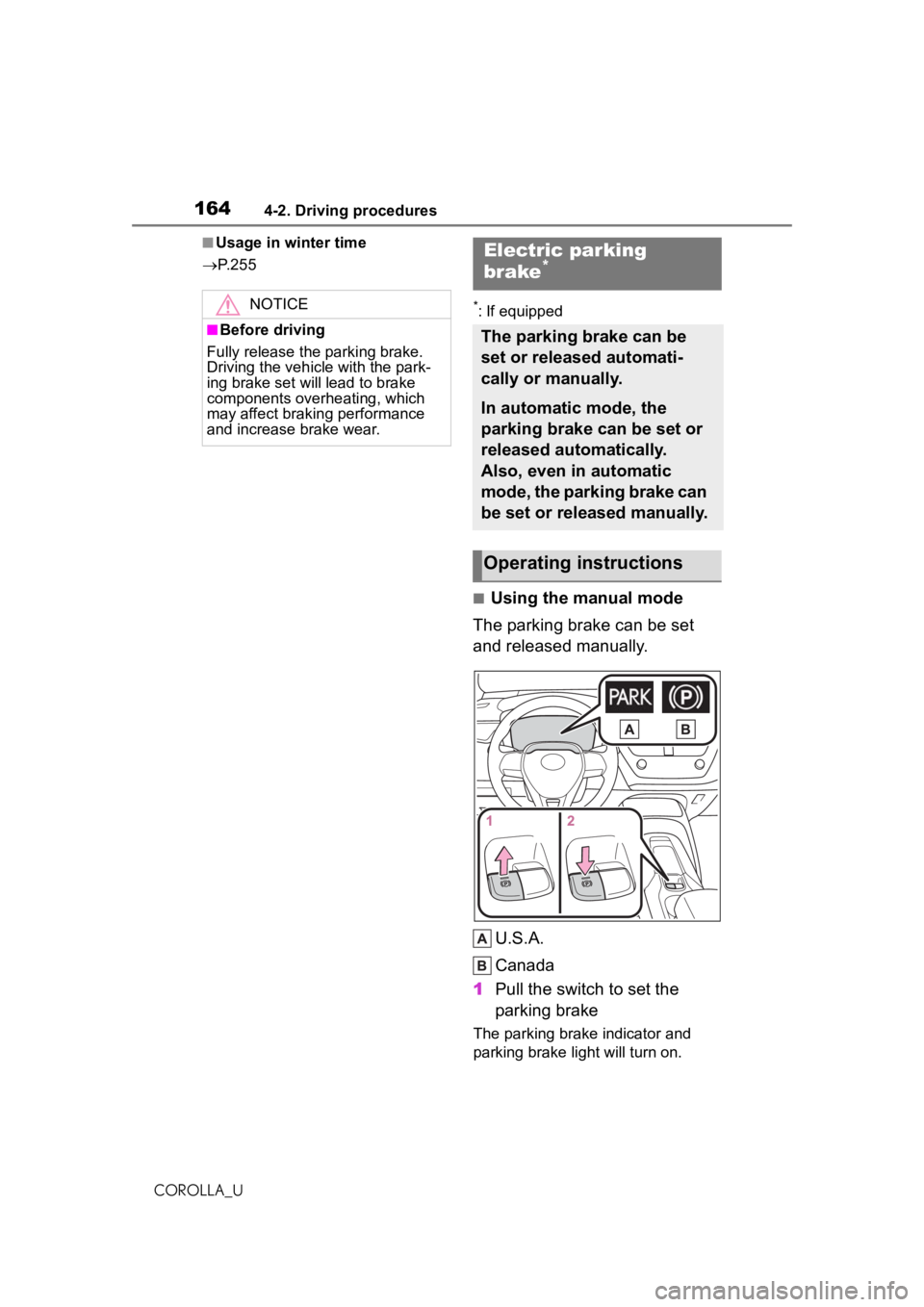
1644-2. Driving procedures
COROLLA_U
■Usage in winter time
P. 2 5 5
*: If equipped
■Using the manual mode
The parking brake can be set
and released manually.
U.S.A.
Canada
1 Pull the switch to set the
parking brake
The parking brake indicator and
parking brake light will turn on.
NOTICE
■Before driving
Fully release the parking brake.
Driving the vehicle with the park-
ing brake set will lead to brake
components overheating, which
may affect braking performance
and increase brake wear.
Electric parking
brake*
The parking brake can be
set or released automati-
cally or manually.
In automatic mode, the
parking brake can be set or
released automatically.
Also, even in automatic
mode, the parking brake can
be set or released manually.
Operating instructions
Page 165 of 588
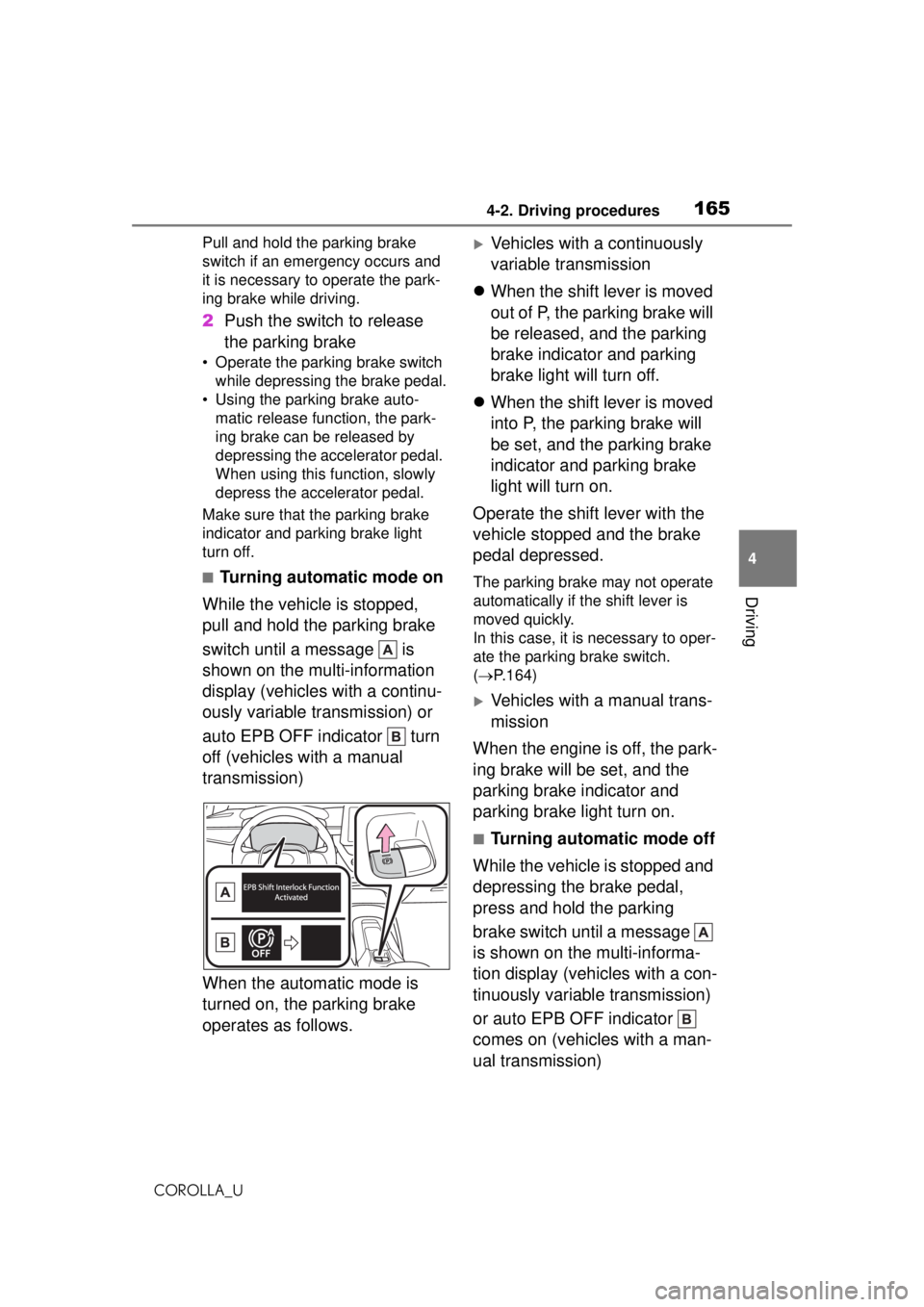
1654-2. Driving procedures
COROLLA_U
4
Driving
Pull and hold the parking brake
switch if an emergency occurs and
it is necessary to operate the park-
ing brake while driving.
2 Push the switch to release
the parking brake
• Operate the parking brake switch
while depressing the brake pedal.
• Using the parking brake auto- matic release function, the park-
ing brake can be released by
depressing the accelerator pedal.
When using this function, slowly
depress the accelerator pedal.
Make sure that the parking brake
indicator and parking brake light
turn off.
■Turning automatic mode on
While the vehicle is stopped,
pull and hold the parking brake
switch until a message is
shown on the multi-information
display (vehicles with a continu-
ously variable transmission) or
auto EPB OFF indicator turn
off (vehicles with a manual
transmission)
When the automatic mode is
turned on, the parking brake
operates as follows.
Vehicles with a continuously
variable transmission
When the shift lever is moved
out of P, the parking brake will
be released, and the parking
brake indicator and parking
brake light will turn off.
When the shift lever is moved
into P, the parking brake will
be set, and the parking brake
indicator and parking brake
light will turn on.
Operate the shift lever with the
vehicle stopped and the brake
pedal depressed.
The parking brake may not operate
automatically if the shift lever is
moved quickly.
In this case, it is necessary to oper-
ate the parking brake switch.
( P.164)
Vehicles with a manual trans-
mission
When the engine is off, the park-
ing brake will be set, and the
parking brake indicator and
parking brake light turn on.
■Turning automatic mode off
While the vehicle is stopped and
depressing the brake pedal,
press and hold the parking
brake switch until a message
is shown on the multi-informa-
tion display (vehicles with a con-
tinuously variable transmission)
or auto EPB OFF indicator
comes on (vehicles with a man-
ual transmission)
Page 166 of 588
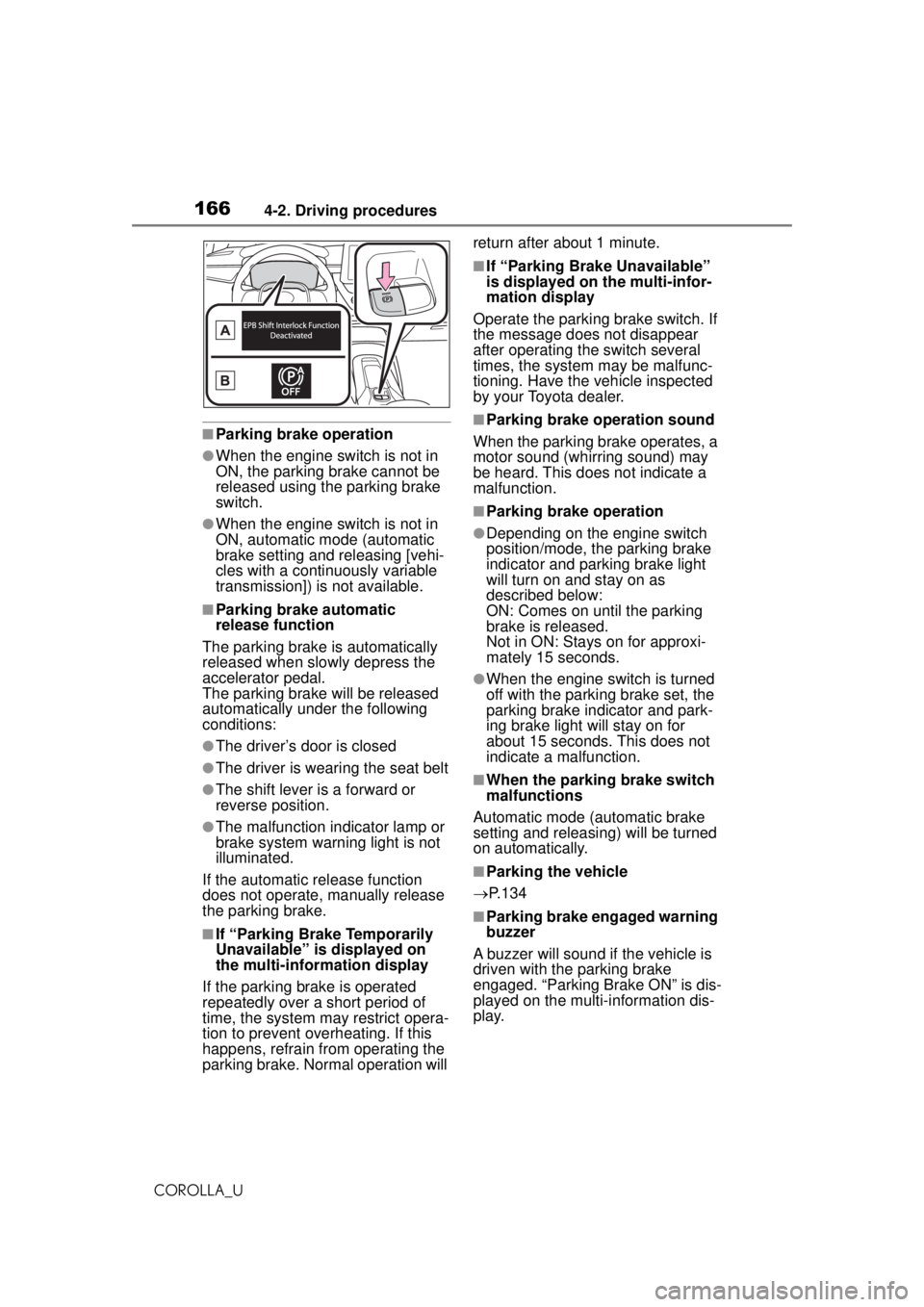
1664-2. Driving procedures
COROLLA_U
■Parking brake operation
●When the engine switch is not in
ON, the parking brake cannot be
released using the parking brake
switch.
●When the engine switch is not in
ON, automatic mode (automatic
brake setting and releasing [vehi-
cles with a continuously variable
transmission]) is not available.
■Parking brake automatic
release function
The parking brake is automatically
released when slowly depress the
accelerator pedal.
The parking brake will be released
automatically under the following
conditions:
●The driver’s door is closed
●The driver is wearing the seat belt
●The shift lever is a forward or
reverse position.
●The malfunction in dicator lamp or
brake system warning light is not
illuminated.
If the automatic release function
does not operate, manually release
the parking brake.
■If “Parking Brake Temporarily
Unavailable” is displayed on
the multi-information display
If the parking brake is operated
repeatedly over a short period of
time, the system may restrict opera-
tion to prevent overheating. If this
happens, refrain from operating the
parking brake. Norm al operation will return after about 1 minute.
■If “Parking Brake Unavailable”
is displayed on the multi-infor-
mation display
Operate the parking brake switch. If
the message does not disappear
after operating the switch several
times, the system may be malfunc-
tioning. Have the vehicle inspected
by your Toyota dealer.
■Parking brake operation sound
When the parking brake operates, a
motor sound (whirring sound) may
be heard. This does not indicate a
malfunction.
■Parking brake operation
●Depending on the engine switch
position/mode, the parking brake
indicator and parking brake light
will turn on and stay on as
described below:
ON: Comes on until the parking
brake is released.
Not in ON: Stays on for approxi-
mately 15 seconds.
●When the engine switch is turned
off with the parking brake set, the
parking brake indicator and park-
ing brake light will stay on for
about 15 seconds. This does not
indicate a malfunction.
■When the parking brake switch
malfunctions
Automatic mode (automatic brake
setting and releas ing) will be turned
on automatically.
■Parking the vehicle
P.134
■Parking brake engaged warning
buzzer
A buzzer will sound if the vehicle is
driven with the parking brake
engaged. “Parking Brake ON” is dis-
played on the multi-information dis-
play.
Page 167 of 588
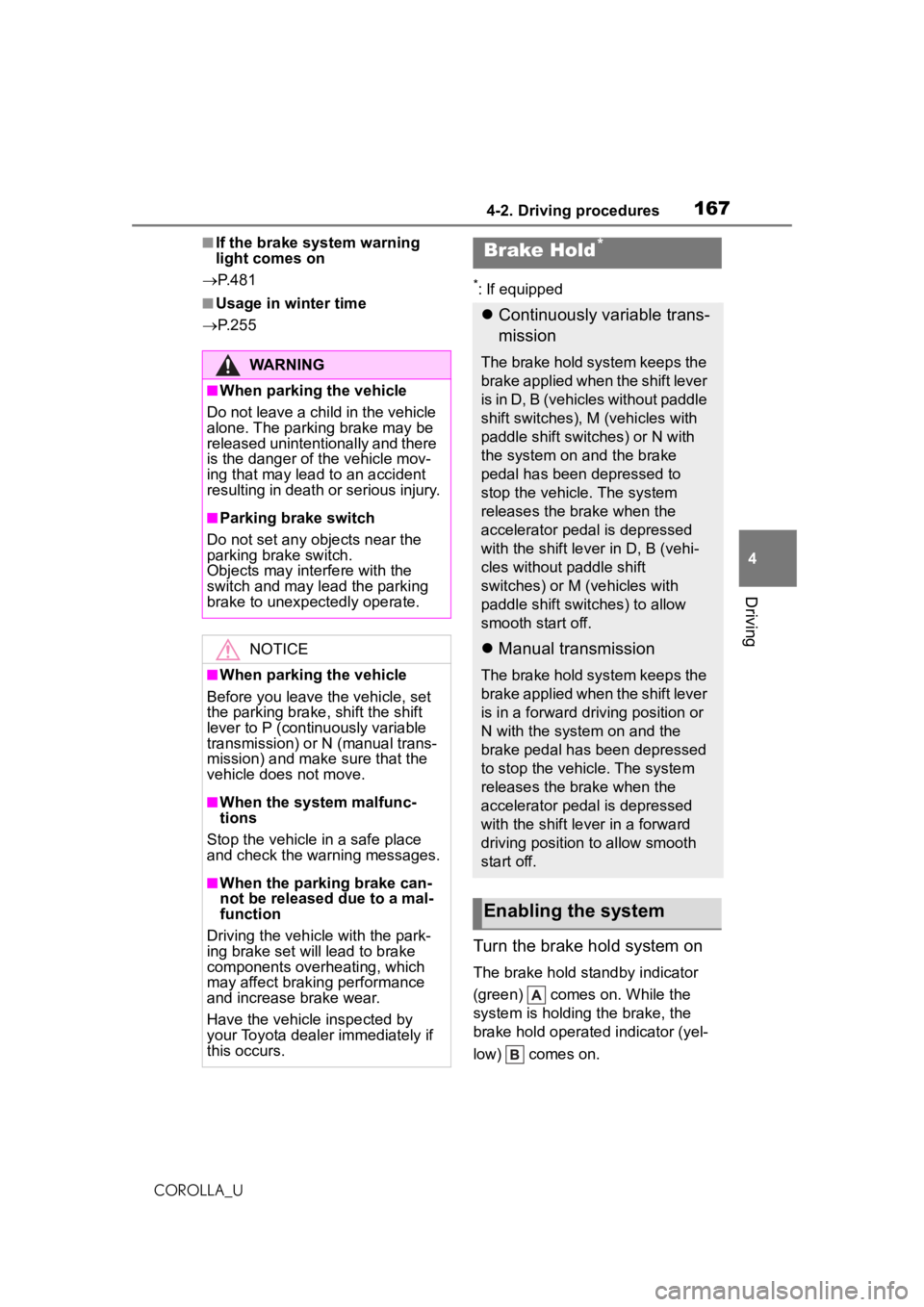
1674-2. Driving procedures
COROLLA_U
4
Driving
■If the brake system warning
light comes on
P. 4 8 1
■Usage in winter time
P. 2 5 5
*: If equipped
Turn the brake hold system on
The brake hold standby indicator
(green) comes on. While the
system is holding the brake, the
brake hold operated indicator (yel-
low) comes on.
WARNING
■When parking the vehicle
Do not leave a child in the vehicle
alone. The parking brake may be
released unintentionally and there
is the danger of the vehicle mov-
ing that may lead to an accident
resulting in death or serious injury.
■Parking brake switch
Do not set any objects near the
parking brake switch.
Objects may interfere with the
switch and may lead the parking
brake to unexpectedly operate.
NOTICE
■When parking the vehicle
Before you leave the vehicle, set
the parking brake, shift the shift
lever to P (continuously variable
transmission) or N (manual trans-
mission) and make sure that the
vehicle does not move.
■When the system malfunc-
tions
Stop the vehicle in a safe place
and check the warning messages.
■When the parking brake can-
not be released due to a mal-
function
Driving the vehicle with the park-
ing brake set will lead to brake
components overheating, which
may affect braking performance
and increase brake wear.
Have the vehicle inspected by
your Toyota dealer immediately if
this occurs.
Brake Hold*
Continuously variable trans-
mission
The brake hold system keeps the
brake applied when the shift lever
is in D, B (vehicles without paddle
shift switches), M (vehicles with
paddle shift switches) or N with
the system on and the brake
pedal has been depressed to
stop the vehicle. The system
releases the brake when the
accelerator pedal is depressed
with the shift lever in D, B (vehi-
cles without paddle shift
switches) or M (vehicles with
paddle shift switches) to allow
smooth start off.
Manual transmission
The brake hold system keeps the
brake applied when the shift lever
is in a forward driving position or
N with the system on and the
brake pedal has been depressed
to stop the vehicle. The system
releases the brake when the
accelerator pedal is depressed
with the shift lever in a forward
driving position to allow smooth
start off.
Enabling the system
Page 168 of 588
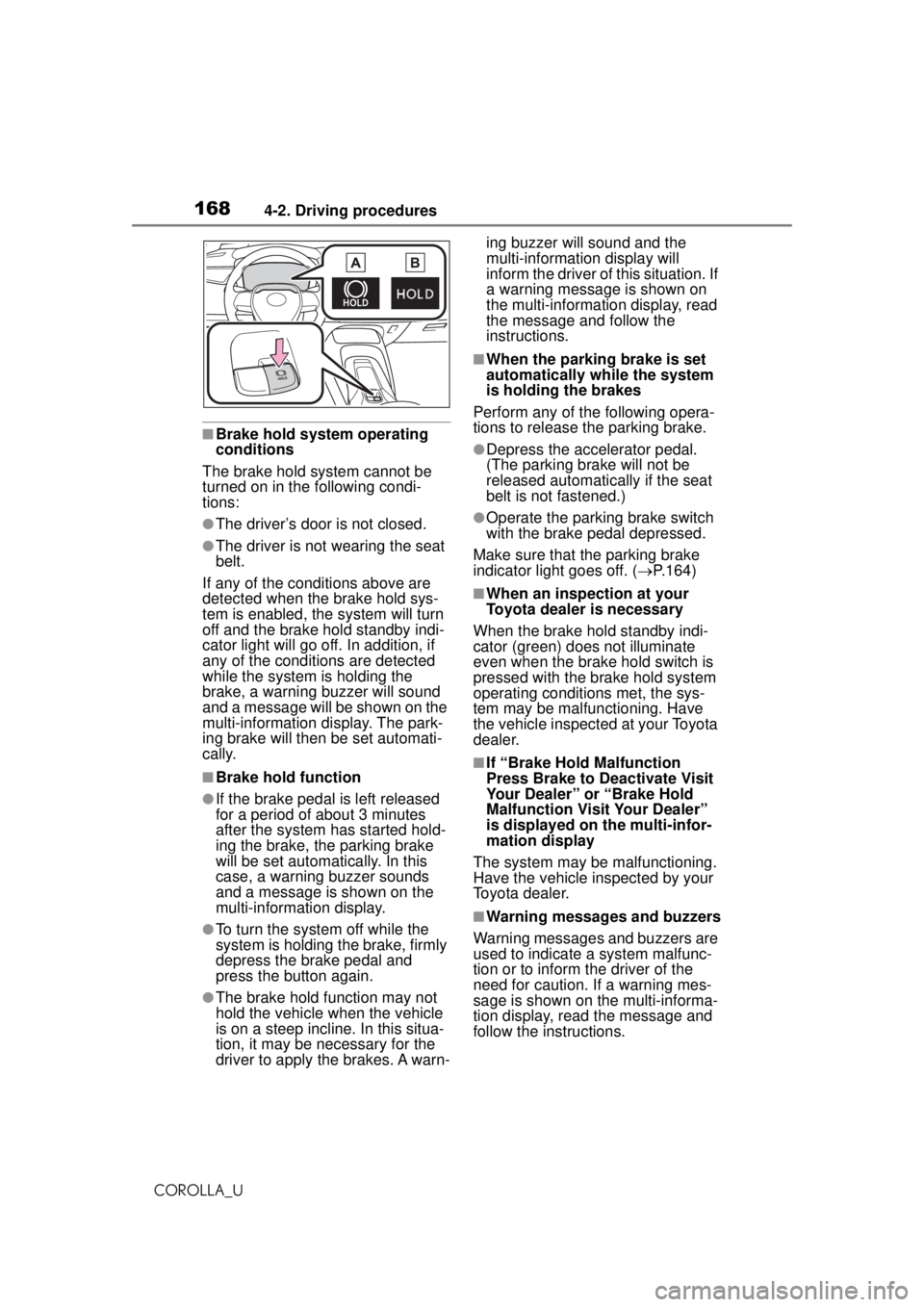
1684-2. Driving procedures
COROLLA_U
■Brake hold system operating
conditions
The brake hold system cannot be
turned on in th e following condi-
tions:
●The driver’s door is not closed.
●The driver is not wearing the seat
belt.
If any of the conditions above are
detected when the brake hold sys-
tem is enabled, the system will turn
off and the brake hold standby indi-
cator light will go off. In addition, if
any of the conditions are detected
while the system is holding the
brake, a warning buzzer will sound
and a message will be shown on the
multi-information display. The park-
ing brake will then be set automati-
cally.
■Brake hold function
●If the brake pedal is left released
for a period of about 3 minutes
after the system has started hold-
ing the brake, the parking brake
will be set automatically. In this
case, a warning buzzer sounds
and a message is shown on the
multi-information display.
●To turn the system off while the
system is holding the brake, firmly
depress the brake pedal and
press the button again.
●The brake hold function may not
hold the vehicle when the vehicle
is on a steep incline. In this situa-
tion, it may be necessary for the
driver to apply the brakes. A warn- ing buzzer will sound and the
multi-information display will
inform the driver of this situation. If
a warning message is shown on
the multi-information display, read
the message and follow the
instructions.
■When the parking brake is set
automatically while the system
is holding the brakes
Perform any of the following opera-
tions to release the parking brake.
●Depress the accelerator pedal.
(The parking brake will not be
released automatically if the seat
belt is not fastened.)
●Operate the parking brake switch
with the brake pedal depressed.
Make sure that the parking brake
indicator light goes off. ( P.164)
■When an inspection at your
Toyota dealer is necessary
When the brake hold standby indi-
cator (green) does not illuminate
even when the brake hold switch is
pressed with the brake hold system
operating conditions met, the sys-
tem may be malfunctioning. Have
the vehicle inspected at your Toyota
dealer.
■If “Brake Hold Malfunction
Press Brake to Deactivate Visit
Your Dealer” or “Brake Hold
Malfunction Visit Your Dealer”
is displayed on the multi-infor-
mation display
The system may be malfunctioning.
Have the vehicle inspected by your
Toyota dealer.
■Warning messages and buzzers
Warning messages and buzzers are
used to indicate a system malfunc-
tion or to inform the driver of the
need for caution. If a warning mes-
sage is shown on the multi-informa-
tion display, read the message and
follow the instructions.
Page 169 of 588
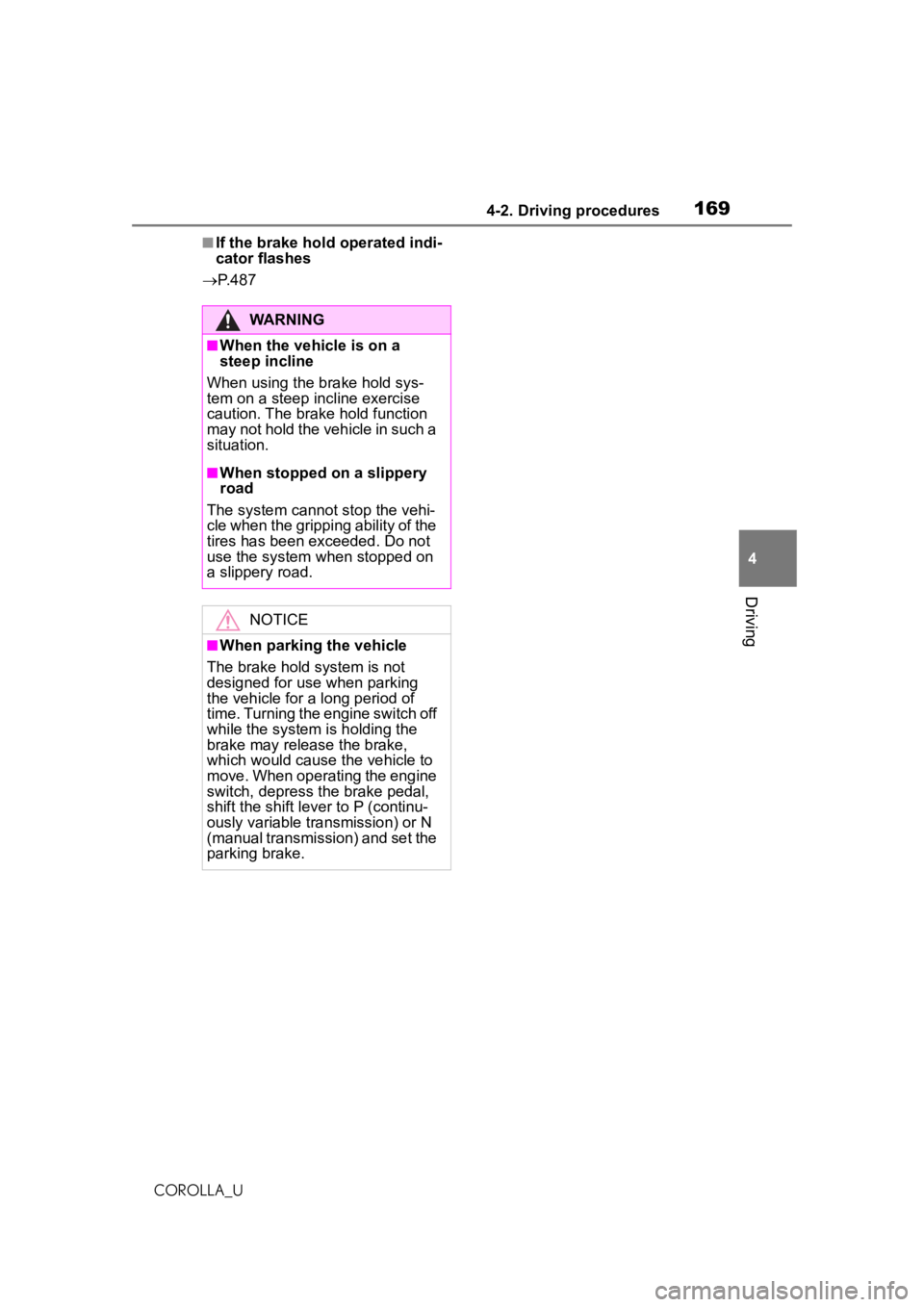
1694-2. Driving procedures
COROLLA_U
4
Driving
■If the brake hold operated indi-
cator flashes
P. 4 8 7
WARNING
■When the vehicle is on a
steep incline
When using the brake hold sys-
tem on a steep incline exercise
caution. The brake hold function
may not hold the vehicle in such a
situation.
■When stopped on a slippery
road
The system cannot stop the vehi-
cle when the gripping ability of the
tires has been exceeded. Do not
use the system when stopped on
a slippery road.
NOTICE
■When parking the vehicle
The brake hold system is not
designed for use when parking
the vehicle for a long period of
time. Turning the engine switch off
while the system is holding the
brake may release the brake,
which would cause the vehicle to
move. When operating the engine
switch, depress the brake pedal,
shift the shift lever to P (continu-
ously variable transmission) or N
(manual transmission) and set the
parking brake.
Page 170 of 588
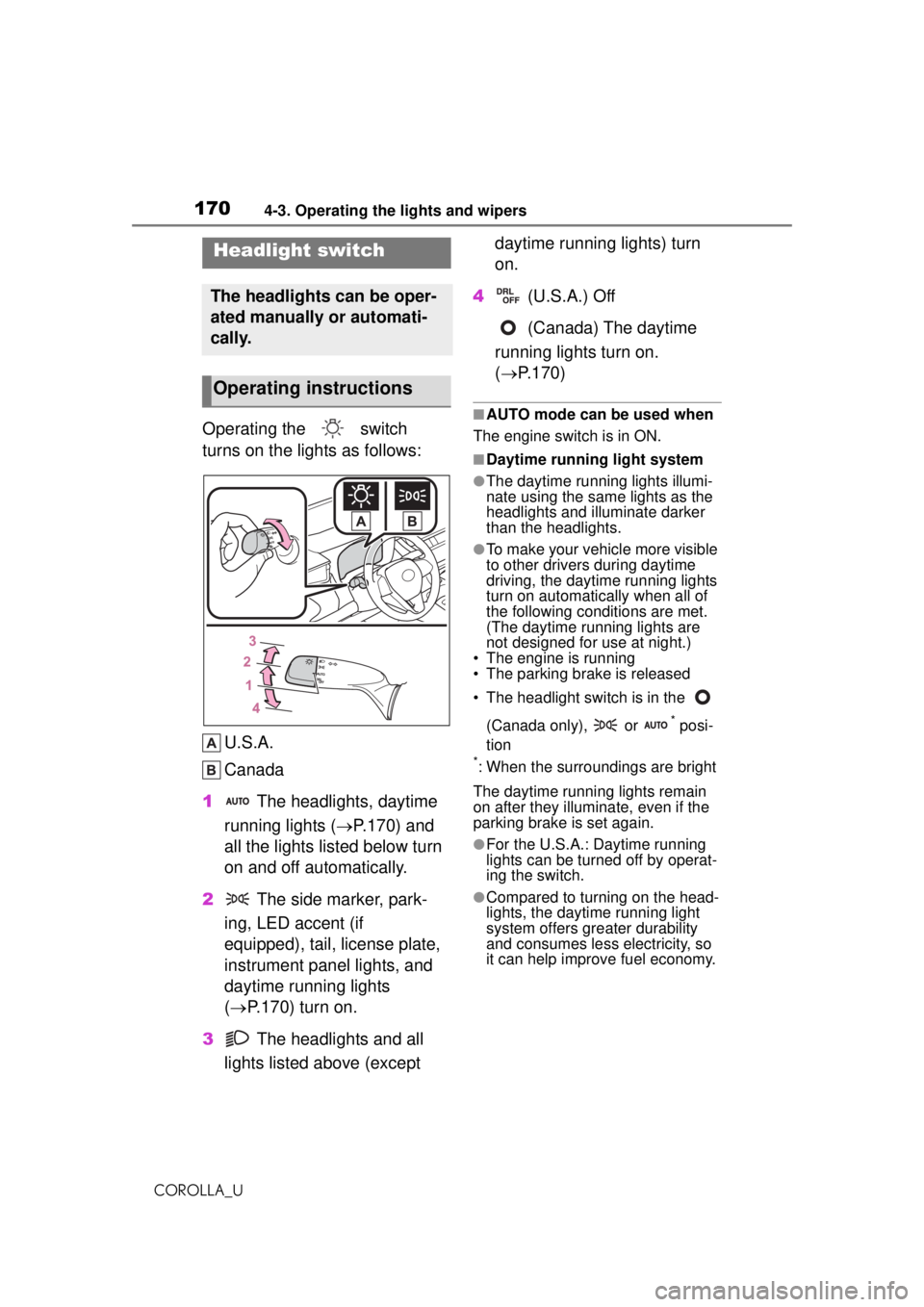
1704-3. Operating the lights and wipers
COROLLA_U
4-3.Operating the lights and wipers
Operating the switch
turns on the lights as follows:U.S.A.
Canada
1 The headlights, daytime
running lights ( P.170) and
all the lights listed below turn
on and off automatically.
2 The side marker, park-
ing, LED accent (if
equipped), tail, license plate,
instrument panel lights, and
daytime running lights
( P.170) turn on.
3 The headlights and all
lights listed above (except daytime running lights) turn
on.
4 (U.S.A.) Off
(Canada) The daytime
running lights turn on.
( P.170)■AUTO mode can be used when
The engine switch is in ON.
■Daytime running light system
●The daytime running lights illumi-
nate using the same lights as the
headlights and illuminate darker
than the headlights.
●To make your vehicle more visible
to other drivers during daytime
driving, the daytime running lights
turn on automatically when all of
the following conditions are met.
(The daytime running lights are
not designed for use at night.)
• The engine is running
• The parking brake is released
• The headlight switch is in the
(Canada only), or
* posi-
tion
*: When the surroundings are bright
The daytime running lights remain
on after they illuminate, even if the
parking brake is set again.
●For the U.S.A.: Daytime running
lights can be turned off by operat-
ing the switch.
●Compared to turning on the head-
lights, the daytime running light
system offers gr eater durability
and consumes less electricity, so
it can help improve fuel economy.
Headlight switch
The headlights can be oper-
ated manually or automati-
cally.
Operating instructions